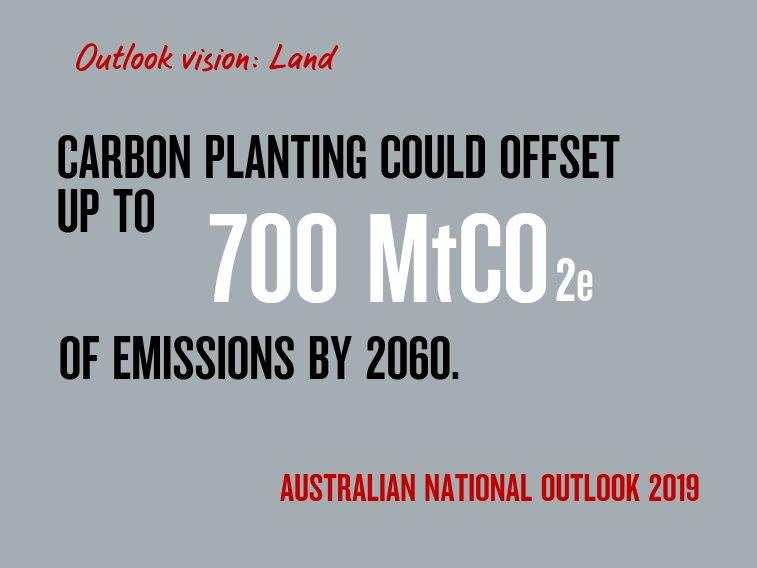Firmer consumer and steady outlook


Insight
A report by CSIRO, NAB and 20 other organisations, draws on the latest scientific data and states that Australia is at a crossroads and faces a stark choice – strive towards a more positive future of growth and prosperity or suffer a slow decline.

In thirty years’ time, Australia’s rural landscapes could look very different to the way they do today, formed by a mosaic of food, fibre production, carbon sequestration and biodiversity.
Returns to landholders could double to as much as $114 billion by 2060 thanks to more productive agriculture on better land and devoting more marginal land to new sources of income such as carbon sequestration.
It’s a vision outlined in the Australian National Outlook 2019 report, which lays out the challenges facing the nation in several key areas and how we should respond.
Slow decline
Under the Slow Decline scenario, Australia drifts into the future. Our GDP grows at only 2.1% annually and real wages are just 40% higher in 2060 than they are today. We’ve continued urban sprawl, consume significantly more energy and make only modest emissions reductions.
Outlook vision
In Outlook Vision, we reach our full potential. GDP grows at 2.8%, real wages are 90% higher, and we’re at zero emissions with potential for negative emissions.
To achieve the vision, Australia needs to make major shifts in five aspects of society and economy:
The land shift
The ANO report outlines three key levers required to produce the healthy and productive landscapes envisaged in Outlook Vision:
The vision centres around landowners deriving additional income off new land uses that will more than offset any reductions in agricultural production, because agricultural production will be centred on more productive land, with less productive land transitioned to other uses.
Invest in productivity
Boosting agricultural productivity is central to the more positive Outlook Vision scenario and brings two important benefits:
These benefits will require agricultural productivity to improve to 3% a year, allowing Australia to remain globally competitive and contribute to growing food demand.
“This level of productivity is a stretch goal that can be achieved by intensifying agriculture on the best land, taking advantage of knowledge and experience from the best farmers and improving productivity throughout the full supply chain using emerging technologies, supported by access to finance and the right market incentives,” the report states.
The goal will require more research and development, and capacity building, as well as the deployment of new and diverse practices, in particular the adoption of real-time decision support technologies to achieve the yield potential of land and agricultural systems, and new genomic insights and tools to raise that yield potential.
Additionally, it’ll need to take account of future changes in climate due to global warming.
There’s a lot at stake. The report warns that without productivity growth, farms could face declining profitability due to rising costs and falling prices and they’d have less chance of withstanding adverse conditions which will be more likely due to climate change.
Capitalise on emerging markets
If governments take strong and cooperative global action on climate change, landowners will be able to sequester carbon through environmental plantings and sell the resulting carbon credits into global carbon markets.
This would deliver environmental and productivity benefits, and at the same time diversify landowners’ revenue streams.
Biosequestration – the process of capturing and storing carbon in living organisms such as plants – would first be used to offset Australia’s own greenhouse emission and then any additional emissions abatement would be available for sale as carbon credits to other countries.
The report states that carbon sequestered in forests could be produced profitably on over 30 million hectares, equivalent to half of the more marginal agricultural land in Australia’s intensive use zone. Planting on this scale means that returns to landowners could more than double to as much as $114 billion per annum and land use industries’ share of national GDP from 2.1% to 5.2% by 2060.
Under Outlook Vision, most carbon forestry would be incorporated into agricultural landscapes as part of a ‘mosaic’ of land uses. The land would be divided into its most profitable and sustainable uses: intensive agriculture in the most productive areas, then livestock and finally a mix of carbon and biodiversity plantings in less manageable landscapes.
Summing up the benefits of carbon farming, the ANO report states: “This new industry brings an opportunity to develop a landscape level solution that satisfies multiple criteria: enough income to invest in diverse plantings, some to maximise carbon sequestration for immediate income and some to prioritise ecosystem restoration for the health of Australia’s natural assets.”
Restore ecosystem health
Once carbon income is included in farm value, there’s an opportunity to re-assess farm valuation approaches and to include a broader set of environmental outcomes that could be monetised.
This is important, because the high agricultural productivity rates necessary for the Outlook Vision outcomes will not be possible without sustaining broader ecosystem health, particularly in the face of climate change.
The report notes that agriculture not only affects the environment but is also highly dependent on the quality of natural assets and the ecosystem services they provide – such as clean air and water and pollination – for its productivity and profitability.
The clearest threat to sustained productivity is worsening soil health as a result of poor ecosystem and land management practices, including long-term erosion, acidification, compaction and nutrient decline.
NAB will be announcing significant commitments aligned with the report.
For a more in-depth analysis of the report findings, download the executive summary or the main report. Or access an overview of the other four shifts required to achieve Outlook Vision:
© National Australia Bank Limited. ABN 12 004 044 937 AFSL and Australian Credit Licence 230686.